
For the second day in a row, Mika Zibanejad skated before his team’s practice in a non-contact jersey. It seems like he’s on the cusp of returning but we’re just not sure exactly when that will be. Maybe they just wanted to give him some extra time with a soft matchup on Monday night.
*
Staying in the region, Jordan Eberle skated in a non-contact jersey with the Islanders. It appears he’s on the mend as well and the Islanders need all the scoring they can get.
*
Jesperi Kotkaniemi was put on the injured reserve but that dates back to October. He’ll be eligible to return as soon as Thursday’s game. In the meantime, Ryan Poehling is going to get a chance to show what he can do on Tuesday night, as he’s skating between Paul Byron and Artturi Lehkonen. At least he’s getting a real chance with real line mates.
*
Not long after returning from injury, Alex Tuch is back out of the lineup for at least the short-term with what the team is calling an upper-body injury. We won’t get more information than that right now, but he didn’t make the trip with the team so don’t expect him back soon.
*
There had been lots of speculation but it was confirmed that Sean Couturier is battling through a shoulder strain. The team admits that he needs rest, and Alain Vigneault admitted using him on faceoffs was against directions from the medical team. Maybe don’t go against what your medical team is telling you?
*
Probably the most surprising team from the first month of the season, to me, is the play of San Jose. We could argue the Oilers, but they have enough talent to ride hot for a month. Buffalo is up there but hey, who remembers when they led the Eastern Conference after like six weeks just a year ago? New Jersey certainly, but there are a lot of moving pieces there. San Jose, on the other hand, lost Joe Pavelski, and it seems their whole team fell apart. As of Monday, they’re tied for last in the West’s standings and are generating fewer shot attempts per 60 minutes than Detroit. Detroit!
What’s most surprising is the duo of Timo Meier and Logan Couture. When skating together last year, that duo helped generate over 65 shot attempts per 60 minutes and controlled over 54 percent of the shots. This year, those numbers are under 50 shot attempts per 60 and controlling under 47 percent of the shots. And no, it’s not Patrick Marleau, as their numbers are as bad without him as with him. (They do generate more shots, but allow more in return, negating any offensive gains.)
Meier, specifically, is concerning. Yes, his shooting percentage is abnormally low, but his shots per game are also down from last year despite more than an extra minute per game of ice time. In fact, his shot rate per 60 minutes is a career-low right now. Not great news for people who may have drafted him near the top-50.
What is wrong with San Jose? I have no idea. My guess is they’re relying on two defencemen to do everything and they can only play so many minutes. Does it get better? Again, I have no idea, but Ottawa fans must be a little excited.
*
In a battle of expected basement teams, Ottawa went into New York and torched the Rangers by a 6-2 score. The new-look top line for the Sens did a lot of the damage, with J-G Pageau putting up a pair of goals, Brady Tkachuk putting up one and one (with six shots and three hits), while Anthony Duclair had an assist, a pair of shots, and a couple penalty minutes.
Vladislav Namestnikov had a goal and an assist, giving him nine points in 11 games in a Sens uniform.
Kaapo Kakko had his first multi-point game, scoring one Rangers goal and assisting on the other. He also played several shifts on the top line with Ryan Strome and Artemi Panarin as the game wore on. Look for him to move up in the team’s next contest.
*
A wild game in Boston as the Bruins took a 3-0 lead, gave that up as Pittsburgh scored four goals in the second period, and then the Penguins coughed up that lead to lose 6-4.
As usual, Boston’s top line did most of the damage: two goals and three assists for Brad Marchand, one goal and one assist for David Pastrnak, one goal for Patrice Bergeron. Jake DeBrusk and Torey Krug added the other tallies.
Not much to say about this one. Pittsburgh goaltending allowed five goals on 25 shots while Jaroslav Halak saved 40/44. That’s just how the game goes sometimes.
Something to watch: Kris Letang only played a few shifts in the third period and then went to the room. He did not return.
*
There was a pretty good Twitter conversation between fans and writers on Sunday morning – or as good as a Twitter conversation can be – about Dougie Hamilton’s season to date. Anyone paying even cursory attention to the NHL has noticed that Hamilton, a guy who was on his third team by the age of 25, was over a point-per-game defenceman through the first month of the season. The conversation, effectively, was around what was behind this breakout. Let’s look at that. (All stats from Natural Stat Trick.)
We should tackle the easy spots first. His shooting percentage is over 15 percent, and that’s obviously not sustainable. He has never shot over seven percent in any season but even cutting it to six percent means he scores three goals this year and still has 13 points in 14 games.
The next obvious improvement over most seasons is his power-play production. As of Sunday night, he was sitting with six power-play points, one fewer than last year, and nine off his career-high 15 PPPs in 2014-15 with Boston. On a per-60 minutes rate, he’s probably over-heating at 8.75. His career-best before this was under 5.00, and last year only two regular defencemen were over 7.5 (Yandle and Krug), and none were above 8.1 So either this level of production continues and Hamilton is probably the most productive defenceman in the NHL with the man advantage, or there’s a slowdown coming.
To compound this problem, Carolina is scoring over 13 goals per 60 minutes on the power play with Hamilton on the ice. This is by far a career-best for him (8.2 in 2013-14), and Victor Hedman led the league last year at 11.6 (the only regular defenceman over 10.7, by the way). He’s over-heating so much that even if the on-ice goals rate declines by 20 percent, it would still be a number high enough to put him around second place in 2018-19. In other words, that’s another area of decline.
So, with all this PP production and context laid out, let’s do some napkin math:
- Hamilton is averaging 2:56 per game with the man advantage. Let’s round that to an even three minutes and assume that maintains for the rest of the season, which is 68 more games for Carolina.
- What the incoming goals regression will be is uncertain, but let’s use 17 percent shooting on the power play as a unit, a number that would have been top-5 in the league last year. A rate of about 90 shot attempts per 60 minutes (Hamilton’s current on-ice rate) means about 50 shots per 60 minutes. In 68 games at three minutes per game, Hamilton would be on the ice for 170 shots the rest of the season.
- At a shooting percentage of 17 percent, he’s on the ice for 29 more PP goals this year. A generous individual points percentage on goals scored would be 75 percent (Hamilton has reached that mark twice before but that would be an elite mark compared to other defencemen last year). That gives him 22 PPPs the rest of the way.
There’s a baseline, and that’s one using generous shooting percentage and IPP rates. Twenty-two PPPs the rest of the way, giving him 27 total this year. His current paces would have him closer to 35. In other words, even assuming some generous rates, Hamilton is due for at least a 20 percent PPP regression.
When discussing his five-on-five production, the shooting percentage is a big part of it, but we already kind of covered that. What is important to note is that he has zero secondary assists at five on five. While his primary assist rate is kind of high, his secondary assist rate is obviously low. A shooting percentage more in his range (about 6.25 percent) means 9-10 more goals the rest of the year. Once his assist rates normalize, we can expect about 19-20 more assists, assuming constant goal and IPP rates. (His IPP, by the way, is a bit high but not extreme. It’ll come down but shouldn’t crash.)
All told, if things regress but are still top-end league-wide, we can expect about another 50 points the rest of the way. If regression hits a bit harder, we could be closer to 40. The point being, though, that the team is generating shots and goals at a rate that isn’t extreme at five on five and though it will regress on the power play, as long as Hamilton keeps getting three minutes a game, it won’t matter a whole lot.
The point of all this is that yes, Hamilton is the beneficiary of some luck right now. But the team around him is playing very well and he’s being trusted with the most minutes of his career (which is about five years overdue). No, he won’t be an 80-point defenceman this year, but 60 is very much within reach. I don’t own him in any leagues, but I wouldn’t be looking to sell him high if I did. This is a defenceman who has 15 goals, 60 points, 200 shots, 100 blocks, and 100 hits all well within reach. Why sell that?





 FLA
FLA CHI
CHI NYR
NYR PIT
PIT L.A
L.A COL
COL CBJ
CBJ ANA
ANA MTL
MTL TOR
TOR WPG
WPG SEA
SEA S.J
S.J BOS
BOS VAN
VAN STL
STL
